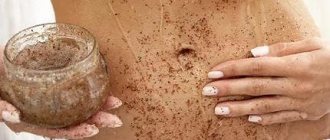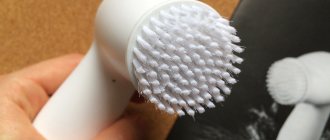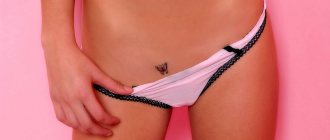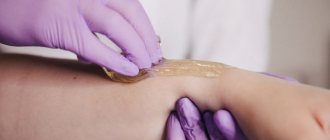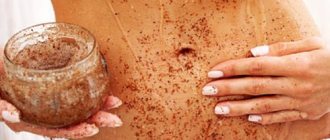Reasons for appearance
Remember! Irritation in the intimate area is the first alarm bell. This is especially true when it appears after shaving. Here you should either change the razor or seek help from a cosmetologist.
After unsuccessful depilation, it happens that the hair does not grow upward, but under the skin. Gradually it curls up into a spiral, and a capsule filled with white contents forms around it. For the body, an ingrown hair is a foreign body that the tissues try to get rid of through an inflammatory process. In this case, itching of the affected area occurs, swelling and redness appear. In the cavity of the formed cone, a hair twisted into a ring is clearly visible.
Girls with naturally thick and curly hair and dry skin with an increased tendency to keratinization often face this problem. The choice of hair removal method does not play a significant role. Incorrect growth can be caused by wax strips or sugaring, as well as a regular razor or cream with chemical components. In some people, the bulbs are located in the skin at an angle from birth, which increases the risk of ingrown hairs.
The cause is shaving too often. After the procedure, the bulb remains in place, and the hair grows weaker and thinner each time. The pores become clogged with fatty secretions and particles of unexfoliated epithelium. The hair is not able to overcome this plug or break through the epidermis, thickened from daily mechanical stress, so it grows inside into the soft tissue. Irritation of the delicate skin can also provoke inflammation.
The problem worries girls with keratosis pilaris, popularly called “goose bumps.” Pathology occurs due to heredity, hormonal imbalances or metabolic disorders in the body, vitamin deficiency. The affected area often becomes infected due to the proximity of the vagina and anus, the mucous membranes of which are home to millions of bacteria, including pathogens. If an ingrown hair in the bikini area becomes a lump with pus, it means that an infection has penetrated through microdamages.
Causes of the defect
There are several factors that predispose you to ingrown hairs.
- Thick skin. If the epidermis is too thick and hard, it is difficult for the rod to break through. It curls up and continues to grow under the skin.
- Hair structure. Coarse and curly hair, due to its growth and structure, is more likely to grow ingrown.
- Dull razor. A low-quality tool leaves injuries and cuts. When using it, there is a need for stronger pressure and repeated processing. Due to significant friction, pubic hair grows after shaving.
- Changes in hormonal levels. Hormones affect the structure and growth characteristics of hair. Therefore, it has been noticed that during pregnancy or before menstruation, ingrowth occurs more often.
- Using depilatory cream. The chemical structure of such products irritates the follicle and leads to impaired hair growth. In addition, the rod becomes thinner and cannot penetrate the epidermis.
- Lack of proper care. After shaving or epilation, the skin should be moisturized and disinfected. Otherwise, bacteria enter the microtraumas, which cause inflammation that interferes with normal hair growth.
- Tight underwear. Friction from clothing leads to thickening of the skin and clogged pores.
- Epilation. Pulling out unwanted vegetation using electrical tools, tweezers, wax or a sugar ball sometimes leads to breaking off the rod under the skin. This causes tissue damage and suppuration. After repeated use of such products, unwanted vegetation becomes thinner. Because of this, pubic hair grows ingrown after hair removal.
Ingrown hairs in the bikini area photo
Getting rid of stains after ingrown hairs at the dermatologist
Skin problems, especially when it comes to hyperpigmentation, which, in essence, are spots that appear due to ingrown hairs, can be solved by a dermatologist or cosmetologist. Among the offered salon treatment options:
- peeling course;
- photorejuvenation;
- laser exposure.
Peeling allows you to soften and remove the upper stratum corneum of the skin, which contains the largest amount of pigment. A course of procedures allows you to get rid of the problem of dark spots after ingrown hairs in a short time.
The use of a laser, like photoepilation, is more likely to be a preventative measure to combat ingrown hairs. After a course of procedures, hair growth stops completely, so you can also forget about ingrown hairs and spots once and for all.
How to get rid of it?
To begin with, it is important to relieve inflammation. The lump can be lubricated with any product intended for the treatment of acne. Lotions with salicylic acid, Baziron or Skinoren gels cope well with inflammation and hyperkeratosis. The tubercle can be cauterized with iodine. The main thing is that the solution does not get on the surrounding healthy skin, otherwise a burn may occur.
You should not try to pick with a needle an ingrown hair in the bikini area that has become a lump. To make the pus resolve, make a compress with Vishnevsky or Levomekol ointment at night. To do this, apply a small amount of the product to a cotton pad, apply it to the lesion and fix it with a band-aid. The procedure is repeated until the purulent contents are released. Only after this, carefully prying the hair with a sterile needle, pull it to the surface and pull it out with tweezers. The wound must be treated with an antiseptic.
Options for preventing and treating ingrown hairs
More attention needs to be paid to softening the skin in the bikini area as a way to prepare it for depilation. Experts also note the importance of using a scrub, shaving gel, and creams with moisturizing and soothing ingredients. If depilation is performed using a razor, then it must be directed in accordance with hair growth. It is not recommended to strongly stretch the skin of the groin folds and pubic area while shaving.
If an ingrown hair in the groin is inflamed, then local application of products intended for the treatment of acne helps. These can be gels and lotions containing salicylic acid, vitamins, and allantoin. Salicylic alcohol or iodine is applied pointwise, only to the top of the dense tubercle, inside of which there is an ingrown hair.
External remedies are used to treat goose bumps, namely creams and ointments containing retinoids, salicylic acid, and hormonal substances. In case of severe inflammation, Levomekol, Belosalik or Akriderm SK ointments are suitable. After drying the inflamed nodule, you need to apply a product to care for problem skin.
Manufacturers of cosmetic products have not remained aloof from this pressing problem. They produce shaving gels and creams, products with AHA acids that provide chemical peeling. Some people find it helpful to use baby cream, vegetable oils - peach oil, grape seeds - to care for dry skin. You can take baths with the addition of infusion of birch leaves and buds. Procedures in a Russian bath soften and cleanse the skin well. The same effect on the bikini area is exerted by baths and compresses with a warm infusion of walnut leaves, sage, calendula flowers, and thyme herbs, which can be used at home.
Women should pay attention to the fact that after using a razor, depilatory cream, or wax strips, ingrown hairs may increase. You can use another method of depilation of the bikini area, for example, sugaring.
Preventive actions
To avoid unpleasant ingrown hairs, just follow a few simple rules:
- For hyperkeratosis and increased dryness, periodically use scrubs to exfoliate the upper keratinized layer of the epidermis.
- For shaving, be sure to use special gels or foams that soften the epithelium. It is better to choose products with alpha hydroxy acids, which act like a light peeling, dissolving dead scales. Soap cannot be used for these purposes, as it only aggravates dryness.
- Before shaving, steam the treated area. You can take a bath with salt or herbal infusions (sage, calendula, thyme), and stand in a hot shower for a few minutes.
- The blade should be sharp and cut all the hairs in one motion.
- During the depilation procedure, it is undesirable to stretch the integument too much.
- Finally, lubricate the skin with a soothing and anti-irritation cream with allantoin or dexpanthenol. To moisturize the dry bikini area, you can use regular baby cream and natural oils (peach, grape seed, jojoba).
It is important to choose exactly the method of getting rid of unwanted hair that least traumatizes the skin. Some girls prefer to use a razor. Others notice that after sugaring, hairs grow in less often. But if no method saves you from the problem, then it is better to go to a beauty salon. The specialist will recommend radical hair removal procedures - photo, laser or ATF hair removal. This will allow you to forget about annoying vegetation, if not for life, then for decades for sure.
Ways to solve the problem
If there is no inflammation, and the ingrown hairs are loops on the surface of the skin, you can get rid of them yourself. The most effective method of eliminating the problem is mechanical removal of ingrown hairs.
First, you should thoroughly steam your skin. The best way to do this is to take a hot bath. You can also place a towel soaked in hot water on your pubic area. Then, using a scrub, you need to remove the stratum corneum of the epidermis. When the pores are maximally open, they need to be disinfected with medical alcohol, chlorhexidine or hydrogen peroxide. In principle, any antiseptic will do.
Then the rods must be carefully pulled out using a needle or tweezers. The instrument should also be disinfected. It is important to treat damaged areas throughout the procedure to avoid infection.
If noticeable painful bumps appear on the pubis, or ulcers or boils form on the skin, you should not try to open them. If you have a problem like this, you should contact your surgeon.
Folk recipes for purulent pimples after depilation
Why do we always highlight folk remedies in a separate blog? Yes, because some people prefer these time-tested means. But there are also those who trust commercially available cosmetic products more.
You can cope with pustules after hair removal using folk remedies. And then they will come to our aid
Chamomile, calendula and aloe are familiar to everyone for a long time.
An infusion is prepared from chamomile and calendula. You can buy these herbs at any pharmacy. So, pour a tablespoon of herb with a glass of boiling water and leave to brew for about 20 minutes. We use this infusion for lotions: take a cotton pad, soak it in the resulting liquid and apply it to the problem area. These herbs have been known since ancient times for their anti-inflammatory effect.
If you don’t have dry herbs at home, then an alcohol tincture of calendula will do. Take a cotton swab, soak it in the tincture and gently wipe the pimple with it. This procedure can be performed several times a day. In addition to the standard properties of calendula, the tincture has an additional effect: due to its alcohol content, it dries the skin in problem areas and serves as an antiseptic.
Well, if you have aloe at home, then this is your savior! We take a leaf of the plant, wash it well, cut it in half and apply the pulp to the problem area. Aloe helps relieve inflammation not only in the case of pustules after hair removal, but also in other problems of a similar nature.
What do ingrown hair spots look like?
Dark spots visually vary depending on the reason for their appearance. They come in two types:
- Dark - brown, bluish or dark burgundy. Such spots appear if you visit a solarium or beach after hair removal. In addition, they may remain after wounds caused by improper depilation have healed.
- Red - formed from suppuration of the hair follicle. The cause may be dry skin or tight underwear.
Dark spots can last up to several months, only becoming slightly paler over time. The red ones are much easier to get rid of. With the right approach, they disappear completely in a couple of weeks.
How to treat purulent pimples?
If pimples still appear after hair removal, they must be treated. What can come to our aid here?
- Creams for acne on the face (Metrogil, Zinerit);
- Healing creams (Rescuer, Panthenol);
- Disinfectants (Boro Plus, salicylic acid, chlorhexidine).
In principle, in order to combat pustules, Miramistin, iodine, and medical alcohol can be used. There is a lot of individuality here!
Judging by the reviews, salicylic acid helps best. The pimple is smeared with the solution for several days, after which it disappears. Salicylic acid is an excellent disinfectant. If you wipe your skin with it before and after hair removal, acne will not appear at all!
What to do if purulent pimples appear after sugaring? Peeling of the skin and irritation after sugaring can be relieved with Panthenol, and chlorhexidine will help remove herpetic rashes. In the case of the development of furunculosis, salicylic or boric acid will come to the rescue: pimples are treated with one of these drugs every 2 hours, plus a comprehensive cleansing of the body is required. Pustules that appear at the site of ingrown hairs are removed using compresses from ichthyol ointment, and microdamages are treated with any healing ointment.
Why do purulent pimples appear?
In general, after depilation, various rashes may appear on the skin: blackheads (usually appear after a dull or old razor), acne and purulent pimples, as well as allergic rashes. And the main problem is precisely pustules, since improper skin care if they are present can lead to serious consequences - infection and inflammation.
Since you need to know the enemy by sight, we list the main reasons for the appearance of ulcers:
- Neglect of personal hygiene rules . When removing hair from any part of the body, the top layer of skin is also affected. Therefore, after hair removal, it is very vulnerable to microbes that can be found both on your body and on the hands of the specialist.
- Very sensitive skin (or individual reaction of the body to mechanical stress) . If your skin is also highly sensitive, then the likelihood of inflammation and purulent acne after depilation increases significantly. Here even sweat and dust can seriously aggravate the situation.
- Skin reaction to the first epilation . If you are epilating a specific area of skin for the first time or using a new procedure for hair removal for the first time (for example, you decided to undergo sugaring for the first time), then purulent pimples may appear precisely because of the procedure that is unusual for the skin. Over time, the skin gets used to it and with subsequent procedures, acne no longer appears.
- “Wrong” hair removal method . Some hair removal methods are traumatic; after removing unnecessary hairs using these methods, microdamages remain on the skin. And such microdamages are simply a paradise for microbes and the spread of various types of infections.
- Direct infection . The infection can come from dirty tools, someone else's machine or epilator, or from the hands of a master.
- Inflammation at the site of ingrown hair . Ingrown hair clogs the sebaceous gland and inflammation begins in this place and a white pimple appears.
- Allergy . Purulent acne can be an allergic reaction to products used for hair removal or after it: wax components, moisturizing creams, special sprays.
- Weak immunity and hormonal problems . Purulent pimples may appear after hair removal due to the presence of a chronic disease, as well as hormonal imbalances. Hormonal disruptions are especially typical for young girls: acne after depilation in the bikini area on the face is typical.
- Clogging hair follicles with cream . Very often, purulent pimples appear due to the fact that the open hair follicles after the procedures are clogged with the moisturizing cream that you apply after the procedures.
One way or another, all of the listed reasons for the appearance of purulent pimples after hair removal are associated with compliance with the rules of personal hygiene and the rules of the hair removal procedure itself. Therefore, in order not to treat purulent acne, it is necessary to monitor the hygienic component of any hair removal procedure.
There will be no risk of infection or allergy - there will be no pustules - there will be no need to treat them.
The main mistakes in sugaring that lead to ingrown hairs
It happens that a person was not familiar with such a problem and never struggled with it. But unpleasant consequences still occurred after the sugaring procedure. Ingrown hairs into the skin can be associated not only with the individual characteristics of the body, but also with the specific reasons due to which such a disease appeared. The main mistakes of the master who performed the hair removal procedure:
- The caramel was applied in the direction of hair growth. This way they were not completely captured and pulled out and could break off in the process. Also, the hair shaft could be bent or the position of the bulb could change, which also provoked the occurrence of a similar problem.
- removing the paste against hair growth, which also leads to bending of the rod with further ingrowth into the skin.
Troubles can be caused by improper preparation of the client for the sugaring procedure:
- A couple of days before the procedure, the client needs to treat the skin with a scrub. Otherwise, the master will not be able to remove all vegetation from his body. Unremoved keratinized areas of the skin will prevent this from happening, because it will be difficult for soft and thin hairs to break through this barrier; they will bend, twist and begin to grow into the skin, forming inflammation.
